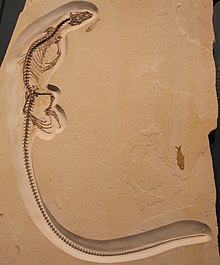Varanidae
| Varanids | |
|---|---|

| |
| Male Varanus komodoensis) fighting, Indonesia
| |

| |
| Fossil of Saniwa, an extinct varanid known from the Eocene of North America | |
| Scientific classification | |
| Domain: | Eukaryota |
| Kingdom: | Animalia |
| Phylum: | Chordata |
| Class: | Reptilia |
| Order: | Squamata |
| Superfamily: | Varanoidea |
| Family: | Varanidae Merrem, 1820 |
Genera
| |
| |
The Varanidae are a
Taxonomy
The Varanidae were defined (using morphological characteristics) by Estes, de Queiroz and Gauthier (1988) as the clade containing the most recent common ancestor of
Lee (1997) created a different definition of the Varanidae, defining them as the clade containing Varanus and all taxa more closely related to Varanus than to Lanthanotus;
Genera
- Genera marked with † are extinct
Genera included in Varanidae according to Dong et al., 2022[2]
- †Ovoo Norell, Gao, & Conrad, 2008[10](Mongolia, Late Cretaceous)
- †Aiolosaurus Gao and Norell, 2000[10] (Mongolia, Late Cretaceous)
- †Cherminotus Borsuk-Bialynicka, 1984 (Mongolia, Late Cretaceous)
- †Saniwides Borsuk-Bialynicka, 1984 (Mongolia, Late Cretaceous)
- †Paravaranus Borsuk-Bialynicka, 1984 (Mongolia, Late Cretaceous)
- †Proplatynotia Borsuk-Bialynicka, 1984 (Mongolia, Late Cretaceous)
- †Telmasaurus Gilmore, 1943[10] (Mongolia, Late Cretaceous)
- †Saniwa Leidy, 1870 (Europe, North America, Eocene)
- †Archaeovaranus Dong et al., 2022 (China, Eocene)
- VaranusShaw, 1790
Phylogeny
Below is a cladogram from Dong et al. 2022.[2]
| Varanidae |
| ||||||||||||||||||||||||||||||
Biology
Monitor lizards are reputed to be among the most intelligent lizards. Most species
Varanids possess unidirectional pulmonary airflow, including air-sacs akin to those of birds.[15]
See also
- Aigialosauridae
- Helodermatidae
- Mosasauridae
- Necrosauridae
